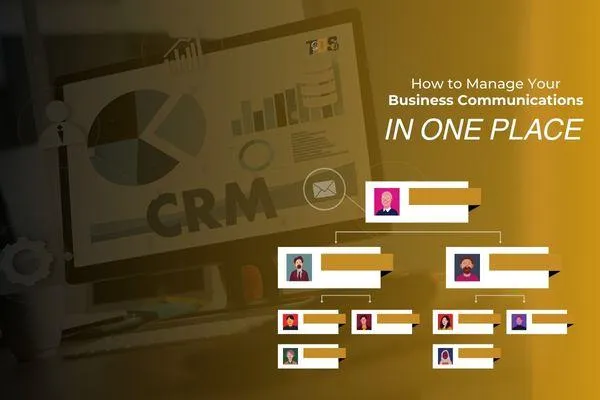
How To Manage Your Business Communications in One Place
Managing a business has become increasingly complex with so many platforms in use emails, messaging apps, video conferencing tools, CRMs, and customer service chat tools. If you're jumping between multiple tabs and apps daily, you're not alone. Most businesses today struggle with fragmented communication, leading to missed opportunities, slower workflows, and frustrated teams.
But it doesn’t have to be this way. Managing your business communications in one place is not just possible, it’s vital to thriving in today’s digital-first world. In this blog, we’ll explore exactly how to consolidate your communications, the tools that make it possible, and how Tier One Services can help you build a centralized, stress-free system that saves you time and drives results.
Why Centralized Communication is the Future of Business
The average business relies on 8 to 15 different communication and collaboration tools, leading to a fragmented and inefficient workflow. This solid approach often results in missed messages, delayed response times, duplicated efforts, poor internal alignment, and a disjointed customer experience. As companies scale, these inefficiencies compound, creating operational friction and harming productivity. A business communication automation platform solves this by integrating all conversations, files, and workflows into one unified space. Teams can collaborate in real time, access information faster, and provide a more consistent experience for clients. In today’s fast-paced digital world, streamlined communication isn’t optional, it’s necessary for business success.
When your communication is scattered, your productivity and your professionalism take a hit. With a centralized business communication system, everything is unified: team chats, client messages, lead management, customer service, email marketing, SMS, appointment booking, and reporting. It’s a powerful way to streamline operations and enhance collaboration.
Signs You Need a Unified Business Communication Platform
Are your messages scattered across multiple platforms and hard to track? If your team struggles to stay aligned or your clients experience delayed responses, it's a red flag. If any of the following signs sound familiar, it's time to centralize your business communications.
You’re using more than 3 or more tools to communicate internally and externally
Important messages get missed or lost in threads
You don’t have a reliable system for tracking client conversations
Your team wastes time switching between tabs
You struggle to onboard new employees to your tech stack
You can’t measure communication performance
Sound familiar? Then it’s time to rethink your communication setup, streamline every conversation, and gain full visibility into your customer interactions. A unified platform doesn’t just save time, it helps you deliver faster, smarter, and more professional service.
Studies show that businesses using unified communication systems improve team productivity by up to 30%. Managing your business communications in one place not only streamlines workflows but also enhances collaboration and boosts customer satisfaction.
Benefits of One-Place Communication Systems
Consolidating your business communications into an all-in-one CRM and communication tool reduces tool fatigue and enhances productivity across teams. It eliminates the confusion caused by scattered messages and ensures that important information is never missed or duplicated. By centralizing communication, businesses can foster better alignment, respond faster to customers, and operate more efficiently. Here are the key benefits of consolidating your business communication into a unified platform:
1. Streamlined Workflow
Everything from emails and chats to meetings and support tickets lives in one place. That means faster response times, better focus, and more productive workdays.
2. Improved Team Collaboration
Your team collaboration using all-in-one communication tools combine messaging, video calls, file sharing, and project management into a single platform, eliminating the need to juggle multiple apps. Centralized tools foster real-time collaboration, shared visibility, and fewer miscommunications.
3. Better Customer Experience
With all customer interactions tracked in a single dashboard, you can deliver more personalized, timely responses that build trust and loyalty.
4. Enhanced Accountability
A unified communication system allows for message tracking, audit logs, and reporting, so you know exactly who said what and when.
5. Time and Cost Savings
Using one integrated platform eliminates the need to pay for and manage multiple apps. You reduce subscription fees and increase efficiency across the board.
Signs You Need a Unified Business Communication Platform
Using one integrated platform eliminates the need to pay for and manage multiple apps. You reduce subscription fees and increase efficiency across the board. If your team is constantly jumping between tools, missing key updates, or struggling to stay aligned, it’s a clear sign your current setup isn’t working. A unified communication system brings clarity, speed, and structure to your daily operations saving time and frustration.
You’re using more than 3 tools to communicate internally and externally
Important messages get missed or lost in threads
You don’t have a reliable system for tracking client conversations
Your team wastes time switching between tabs
You struggle to onboard new employees to your tech stack
You can’t measure communication performance
Sound familiar? Then it’s time to rethink your communication setup. A scattered approach slows your team down, creates confusion, and leads to missed opportunities. By switching to a unified communication platform, you can streamline workflows, improve accountability, and create a more productive work environment.

Business professionals using an all-in-one communication platform for real-time collaboration. Managing your business communications in one place not only streamlines workflows but also enhances collaboration and boosts customer satisfaction.
Step-by-Step Managing Business Communication in One Place
Whether you’re running a small team or a growing enterprise, having a clear roadmap makes all the difference. By following these proven steps, you’ll streamline communication, reduce confusion, and create a more connected, efficient workplace. The actionable steps that any business owner can follow.
Step 1: Audit Your Current Tools and Communication Channels
Start by making a list of every communication tool your business currently uses by reviewing it. Then, begin by evaluating all the communication platforms your business currently uses. Also, ask yourself: Are these tools integrated or isolated? Are we duplicating conversations across platforms? What’s costing us time or creating confusion?
This step helps you identify redundancies and pinpoint which tools are mission-critical. Remember, conducting this communication audit helps you identify unnecessary overlaps and clarify which tools are truly essential to your workflow. It’s the first step toward streamlining your business communication strategy.
Step 2: Define Your Communication Needs
Choosing the right platform is vital to understanding your unique business requirements. Not every organization communicates the same way, so identifying your priorities ensures you invest in the right tools. Whether you need faster internal messaging, stronger client collaboration, or seamless file sharing, clarifying your needs helps you build a communication system that truly supports your operations.
Do you need an all-in-one CRM with messaging features?
Is automation important for responding to inquiries?
Do you want to integrate email, SMS, and social media messaging in one place?
Do you require client appointment booking features?
By understanding your must-haves, you can choose a solution that truly fits your business model. You can choose a centralized platform that meets your exact needs, without paying for unnecessary features.
Step 3: Choose a Centralized Communication Platform
Once you know what you need, it’s time to pick the right platform. At Tier One Services, we specialize in setting up centralized communication systems that consolidate your tools into all-in-one communication platforms that include:
Email & SMS automation
Unified inbox for email, chat, and social messaging
CRM with contact management and lead tracking
Team collaboration and task assignment features
Appointment and calendar scheduling
Customer pipelines and reporting dashboards
Instead of switching between apps, everything happens in one place, saving time and reducing errors. We create customized solutions that consolidate all your communication and marketing in one user-friendly dashboard.
Step 4: Automate Your Workflows
One of the top benefits of centralizing your business communications is automation. With the right system in place, you can automate repetitive tasks and create seamless workflows, such as:
Automatically sending follow-up emails
Sending text confirmations for appointments
Instantly replying to missed calls with SMS
Nurturing leads with drip campaigns
Assigning customer service requests to the right team member
Automation ensures your communication continues even when you’re not actively working. We implement intelligent automation that ensures your communication processes keep running even when you’re offline. This not only boosts efficiency but also enhances the customer experience.
Step 5: Train Your Team and Set SOPs
A powerful communication system is only effective if your team knows how to use it. Successful implementation starts with proper training and clear standard operating procedures (SOPs). By equipping your team with the right resources and guidelines, you’ll ensure consistent usage, faster adoption, and smoother collaboration across departments.
Clear documentation and Standard Operating Procedures (SOPs)
Training sessions
Role-based access and responsibilities
Ongoing support for troubleshooting and optimization
Once your team is fully trained and your SOPs are in place, it’s time to focus on performance. A well-prepared team using a centralized system opens the door to meaningful data insights. Now, you can begin tracking and optimizing communication efforts for maximum impact. This helps ensure everyone communicates clearly and effectively using the new system.
Step 6: Track Performance and Optimize
Once your business communications are centralized, it becomes easier to measure what’s working and what’s not. With all interactions flowing through a single system, you gain full visibility into key performance metrics that drive success. From response times to lead conversions, these insights empower you to fine-tune your strategy, boost team efficiency, and enhance the overall customer experience. These insights allow you to make informed decisions and continually improve communication efforts.
With clear metrics in hand, you can continually refine your communication strategy to align with business goals. Performance tracking isn’t the final step; it’s an ongoing process that supports long-term growth. Centralizing communication transforms the way your business and successful operates.
Summary
If your business communication feels scattered and overwhelming, you’re not alone. But you don’t have to keep operating this way. Centralizing your business communication gives you back control, boosts efficiency, and helps you deliver better service to your clients.
Whether you’re a small business owner, an entrepreneur, or a remote team leader, Tier One Services helps you manage your business communications in one place, seamlessly and strategically. From the smart tools and guidance, you need to communicate better, faster, and smarter.
Ready to start? Visit www.tieronesvcs.com to schedule your free consultation today!



